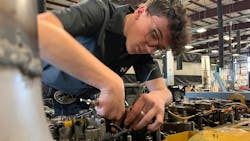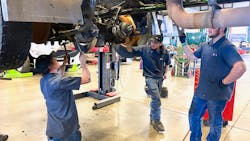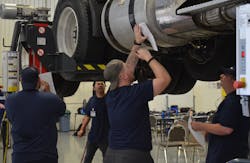Finding and retaining technicians: Understanding the supply and demand
The transportation industry’s maintenance technicians were once viewed as expendable as wear items, like tires or brake pads. That strategy, however, has worn thin, and now fleets and shops find themselves in the throes of a technician shortage that is projected to worsen over the decade.
“For a long time, people in the industry treated a lot of technicians like they were a number— ‘Oh, fine, I’ll go get somebody else,’” said Tyler Robertson, founder and CEO of Diesel Laptops, a provider of diagnostic tools, software, parts, and training. “And those days are long gone.”
Fleet leaders report that finding and keeping technicians is one of the industry’s top challenges. According to Fullbay’s 2022 State of Heavy-Duty Repair Industry Report, more than half of the fleet and independent shops surveyed said hiring technicians was the top challenge, while 65% found hiring “difficult.”
“This is a crisis, and it’s a permanent one if we don’t get our heads around these sourcing and retention issues,” warned Gary Beeman, CEO of New Village Institute (NVI), a Blairsville, Pennsylvania-based diesel and automotive training school that opened in January.
The campus, an hour east of Pittsburgh, is tucked on the Allegheny Mountains’ western ridge, among sprawling forests and cragged hills. It was once a flourishing WyoTech campus, but it closed in 2018. (WyoTech is under new management and runs a nine-month auto and diesel technician training program in Laramie, Wyoming.)
NVI’s first modestly sized class of diesel technicians just graduated in June. The six-month program is broken into four six-week units. The first is fluid power, where they learn about hydraulics, control systems, pumps, and basic electrical—which becomes more important as trucks transition to fully electric powertrains. This is followed by powertrain and brakes; engine management; and finally the engines themselves. By the end, students will understand how to replace a clutch, troubleshoot lighting issues, perform preventive maintenance, diagnose aftertreatment issues, and even tear down and reassemble an engine.Beeman noted fleets asked NVI to compress the training time to six months “because they’re desperate for techs.” These fleets, such as PGT, United Rental, Pitt Ohio, Penske, Ryder, and Waste Management, have helped tailor the curriculum and provide resources to ensure these new technicians can contribute from day one.
“We want to get them in here, give them a skill set, and get them back out into the industry as quickly as possible so that they can start to earn a living, but also help serve that need for technicians in the industry right now,” Beeman said.
What shops need most are workers they can rely on, and NVI’s classroom instruction goes hard on soft skills, those work ethic-related intangibles.
“The soft skills and the life skills are just so important,” Beeman said. “Ninety percent of the game is to be reliable, show up, and have a positive attitude.”
And Beeman is positive NVI will help with the shortage. At max capacity, NVI’s limit is 2,400 students per year, and he said they could reach that number “in the next few years.”
Over at WyoTech, which started back up in 2018 with 12 students, the student body has swelled to 685 this spring, an increase of 2,300%. WyoTech CEO Jim Mathis expects 800 students by the fall.
And fleets and dealerships are traveling out to Wyoming to court them. A job fair this spring attracted more than 70 employers from across the country. Suitors included construction and agricultural companies. John Deere went as far as flying students out to a Colorado equipment dealer.
“If a student wants a job, they could leave with 10 job offers just in those two days,” Mathis said. “That’s how intense and how needed our students and other tradespeople are.”
Twenty years ago, Mathis said the Laramie campus had nearly 2,200 students, and the Blairsville site had 1,500 at one time.
“Our ultimate goal is to have 10,000 students in Laramie on campus by 2030,” Mathis said.
So while help is coming, from these two schools, and several others, it won’t be enough.
The big shortage
Damage control always starts with first assessing the situation, and this one ain’t pretty. As Robertson pointed out, reducing technicians to a number helped create this shortage. Now the industry is left scrambling to add technicians within its ranks.
According to TechForce Foundation’s 2021 Transportation Technician Supply & Demand Report, there are five open automotive or diesel jobs for each new technician completing a post-secondary program.
“Postings for diesel mechanics on Indeed.com have increased 450% since February of 2018,” noted Tim Spurlock, CEO and co-founder of American Diesel Training Centers. “On February 10, 2022, there were more than 55,000 diesel mechanic listings. This is a record number of postings.”He also noted that there are 30,000 heavy-equipment technician openings.
“I think the true number is well over 100,000 because not every company lists all of their openings on Indeed or job boards,” Spurlock said. “This is triple the number of openings on Indeed three to four years ago.”
The issue is likely to get worse before it gets better. The U.S. Bureau of Labor Statistics estimates that every year until 2030, the deficit of diesel and automotive technicians will expand by 28,100.
Part of this is due to many older techs retiring or taking their talents out of the shop and into a better paying, less work-intensive role.
That speaks to the one biggest issue of commercial vehicle maintenance and repair: The job is challenging and not for everybody. Troubleshooting a diesel truck’s aftertreatment system, for example, is not easy work and takes diagnostic expertise and patience, but doing it quickly and accurately is one of the top needs of the trucking industry.
In general, shop life can be demanding, and there is a lot to learn. Many finish vocational or technical school and discover the job isn’t right for them. About 41% will leave the industry within two years, according to a survey by the National Institute for Automotive Service Excellence (ASE) of recent graduates in the trade.
Competition within the industry is another hurdle. Robertson acknowledged that shops aren’t the only ones vying for quality diesel techs. Diesel Laptops, along with other vendors and truck manufacturers like Daimler Truck North America, Paccar, or Volvo Trucks North America, also covet experienced technicians.
“They’re now competing, not just with other shops, but companies like mine and OEM call centers,” explained Robertson, who said 40 of Diesel Laptops’ 200 employees are former diesel technicians. “We’re hiring experienced diesel technicians, paying them a really good wage, and let them work from home. And that’s a hard thing to compete against.”
The pandemic exacerbated the situation, said Spurlock, noting that “community college enrollments, especially skilled trades, tanked after COVID and have not returned.” He counted 6,000 people studying diesel technology receiving Title IV grants, loans, and aid per year, and that “few actually graduate.”
Meanwhile, Spurlock said there is a huge interest in maintaining trucks and other equipment.
“There are hundreds of thousands of people out there who would love to work in this field, but they don’t have the time or funds for an extended training program,” Spurlock continued.
American Diesel Training tries to alleviate some of these issues. Students don’t pay tuition until they are hired, and oftentimes their employer will pick up the costs. The Columbus, Ohio-based school has churned out more than 1,700 entry-level diesel techs since opening in 2017.
The question is how to reach and hire these potential workers.
This article originally appeared in its entirety on FleetMaintenance.com.
About the Author
John Hitch
Editor
John Hitch is the editor-in-chief of Fleet Maintenance, providing maintenance management and technicians with the the latest information on the tools and strategies to keep their fleets' commercial vehicles moving. He is based out of Cleveland, Ohio, and was previously senior editor for FleetOwner. He previously wrote about manufacturing and advanced technology for IndustryWeek and New Equipment Digest.



